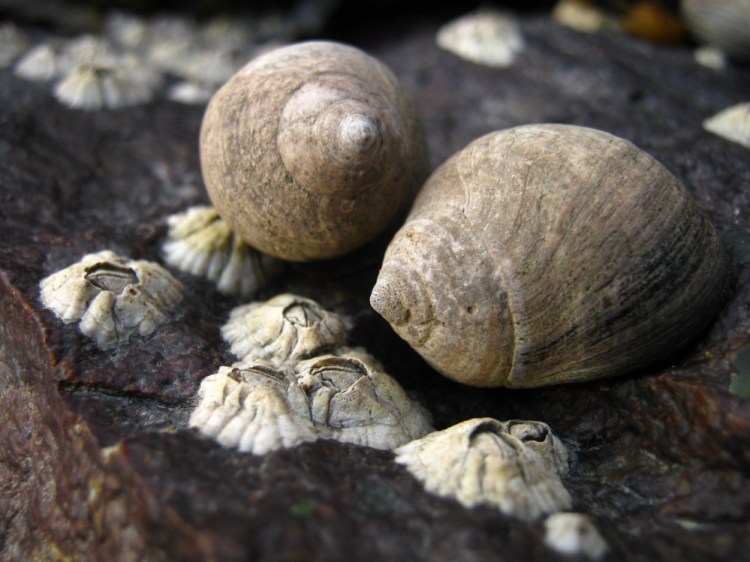Our routines don’t take us down to the fresh ruffles of the surf very often these days, but somehow, the sea is always with me. When I was a kid I lived whole summers digging and scattering sand on beaches in Casco Bay. And more often I poked around in low-tide pools and algaes baking on damp ledges, and malingered under wharves funky with kelp and bait smells.
Down in that gloomy intertidal no-man’s-land, periwinkles were everywhere. They dotted the rocks and pilings, inhabited the seaweed. To a kid they were as motionless as stones and practically inanimate, even though you knew they were alive. Six or eight of them might be arrayed in a trapezoidal shape on a flat spur of ledge, then if you wandered away and later returned, the trapezoid had turned into a U. How did they do that, and when?
Barnacles don’t move at all. They cement their heads directly onto the rock and stay there, but periwinkles suction themselves to flat surfaces at their shell aperture, and shove one foot out to push around, typical of gastropods — a class of mollusks with spiral shells. Periwinkles have soft bodies and a head inside the permanent univalve shell (as opposed to bivalves like clams, scallops and mussels). South of New England there are tremendous varieties of periwinkle kin, from whelks, cowries, conchs and murexes, to wentletraps, tritons and augers. Don’t ask me to identify these creatures I’ve mostly only read about and have no karmic links to. That I know of.
The three main periwinkle species I had a firsthand relationship with as a kid look a lot alike: the common periwinkle (Littorina littorea); the rough periwinkle (L. saxatilis); and the smooth periwinkle (L. obtusata). The common periwinkle has a purple-brown shell, with fewer color variations than the others. The rough periwinkle has deeper ridges in its shell. And the smooth periwinkle tends to look shinier and is often banded and brighter-colored in green and yellow.
The common periwinkles, believe it or not, are an invasive species. The first report of their presence in North America was near Pictou, Nova Scotia, in the 1840s. They appear to have come from Ireland and Scotland, according to a study led by University of Maine marine biologist Susan Brawley, probably on ballast rock picked up in Britain and discharged in the Maritimes. Or possibly they were deliberately transplanted for food. They expanded their new range rapidly, and are now found from Labrador to Delaware, in addition to their original digs on Northern Europe’s coasts.
They scrape algae off rocks and seaweed with a tooth-riddled contraption called a radula, which sticks out of the same aperture as the foot. There are so many of them off our coast that they sometimes devour all the competitors of Irish moss, which takes over in places, disrupting the ecosystem. Life is hazardous in the intertidal zone, and even nastier as you cross the line into the deeper water where their larger cousins the whelks are outright carnivorous.
Periwinkles have sensory organs for feel, smell and taste, and there’s a legend that humming a tune can induce it to open its operculum, or aperture cover, though I’ve never tried this and couldn’t find a scientific website that mentions it. It seems too civilized to be true, but some of my co-workers say they’ve seen it happen.
In Europe and Asia, periwinkles, aka snails, are still commonly eaten, and they’ve been harvested for those markets by Down East “wrinklers” in considerable quantities since about the late 1980s. One year nearly 4 million pounds were taken. More recently the harvest has approached about 1 million pounds a year, according to state figures.
Unless you crush a periwinkle or bore a hole in its shell, the tight-sealed aperture is the only way into it. Years ago, a friend who studied nutritional self-sufficiency experimented with collecting periwinkles on the shore in Portland and boiling them. They’re easier to gather than clams, but eating them turns out to be labor-intensive. The cooked periwinkle meat is hard to dig out without breaking the shell and getting bites full of shards. Unless you’re a green crab, which crushes them in its claw and discards the pieces.
I relate all this gathered-up information from one sort of distance or another. For as I say, we don’t make many voyages to the shore nowadays and I don’t have the same consanguinities with periwinkles that I have with, say, chickadees. So the fascination goes back to chthonic memories, bleached by time and the elements, of shell shucks under low-tide wharves, when it barely registered to me that they were even alive. They were small creeping stones with trap doors.
Back across the line in the daylight world of sun-beaten waves it might have occurred to me you could gather them up and eat them, the way they were eating algae, and algae were eating sunlight. But regretfully I did not contrive that kind of conquest. They were just more bait. It takes some distance to clear up what it means to say the bottom of the sea is cruel.
Dana Wilde lives in Troy. You can contact him at naturalist1@dwildepress.net. Backyard Naturalist appears the second and fourth Thursdays each month.
Copy the Story LinkSend questions/comments to the editors.




Success. Please wait for the page to reload. If the page does not reload within 5 seconds, please refresh the page.
Enter your email and password to access comments.
Hi, to comment on stories you must . This profile is in addition to your subscription and website login.
Already have a commenting profile? .
Invalid username/password.
Please check your email to confirm and complete your registration.
Only subscribers are eligible to post comments. Please subscribe or login first for digital access. Here’s why.
Use the form below to reset your password. When you've submitted your account email, we will send an email with a reset code.